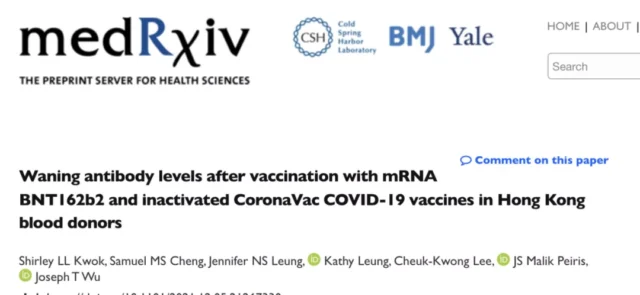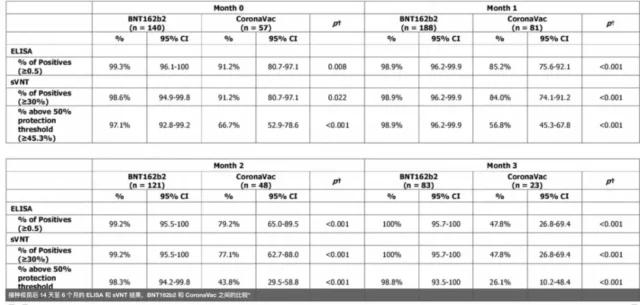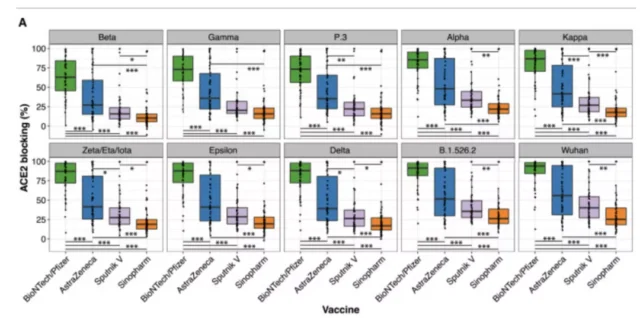medRxiv: How about the protection efficiency of different COVID-19 vaccines?
- Normal Liver Cells Found to Promote Cancer Metastasis to the Liver
- Nearly 80% Complete Remission: Breakthrough in ADC Anti-Tumor Treatment
- Vaccination Against Common Diseases May Prevent Dementia!
- New Alzheimer’s Disease (AD) Diagnosis and Staging Criteria
- Breakthrough in Alzheimer’s Disease: New Nasal Spray Halts Cognitive Decline by Targeting Toxic Protein
- Can the Tap Water at the Paris Olympics be Drunk Directly?
medRxiv: How about the protection efficiency of different COVID-19 vaccines?
- Should China be held legally responsible for the US’s $18 trillion COVID losses?
- CT Radiation Exposure Linked to Blood Cancer in Children and Adolescents
- FDA has mandated a top-level black box warning for all marketed CAR-T therapies
- Can people with high blood pressure eat peanuts?
- What is the difference between dopamine and dobutamine?
- How long can the patient live after heart stent surgery?
medRxiv: How about the protection efficiency of different COVID-19 vaccines? The latest research gives theoretical data.
This week , Two latest studies on the protection of COVID-19 vaccines with different technical routes , respectively, in preprint platform medRxiv and Elsevier published in the journal full-text database .
The former was participated by researchers from the Li Ka-shing School of Medicine at the University of Hong Kong, and evaluated the attenuation of antibodies after inoculation with the mRNA vaccine BNT162b2 and the inactivated vaccine CoronaVac.
And the other is about the infection situation of the COVID-19 epidemic in Mongolia. It was jointly participated by researchers from Stanford University in the United States and related medical institutions in Mongolia.
It compared the antibodies of BNT162b2, adenovirus vaccine Vaxzevria, adenovirus vaccine Sputnik V and inactivated vaccine Sinopharm. level.
Half a year later, BNT162b2 is still above the 50% protection threshold
The Hong Kong University Faculty of Medicine study recruited 850 healthy blood donors who had completed two doses of vaccination. Among them, 593 were vaccinated with BNT162b2 and 257 were vaccinated with CoronaVac. The median age ratio between the two groups was 39:48.

In all the samples collected, the researchers divided the volunteers into 6 groups from 0 to 6 months according to the time after the completion of the two doses of vaccination.
First use the enzyme-linked immunosorbent assay (ELISA) to test, which can detect antibodies against the new coronavirus spike protein receptor binding domain (RBD) .
It is generally believed that the neutralizing antibody titer of the test result is greater than or equal to 0.5 as positive and qualified.
The results of the test showed that the positive rate of people after receiving the mRNA vaccine did not change significantly over time. In the third month after vaccination, the positive rate of the inactivated vaccine dropped from 79.2% to 47.8%.
Based on the average data of 6 months, the positive rate ratio of the two vaccines is 99.2%: 73.2%.
At the same time, for ELISA positive samples, the researchers used the alternative virus neutralization test (sVNT) for further testing.
This test measures neutralizing antibodies that inhibit the interaction between the ACE-2 human cell surface receptor and the new coronavirus spike protein RBD.
Within 6 months, the average positive ratio of mRNA vaccine to inactivated vaccine was 99%: 70.4%.

At the same time, the 50% protection threshold set by the researchers is 45.3% sVNT inhibition level.
The test results showed that the antibody level of the mRNA vaccine was still much higher than the 50% protection threshold after 6 months, while the antibody level of CoronaVac was lower than 50% after 2 months.
Researchers believe that planning the schedule of different vaccines should take into account the rate of attenuation of the corresponding antibody levels.
Inhibition ratio: 90%, 50%, 30% and 25%
The study conducted in Mongolia not only compared the four technical routes of vaccines, but also analyzed the differences in the activity of the vaccines against different types of new coronavirus variants.
A total of 196 volunteers participated in the study of the vaccine group, and plasma samples were collected from July 3, 2021 to July 7, 2021.
Test results showed that BNT162b2 (mRNA vaccine) triggered the strongest RBD-ACE2 blocking antibody activity, followed by Vaxzevria (adenovirus vaccine) and Sputnik V (adenovirus vaccine) , and Sinopharm (inactivated vaccine) had the lowest level .
The inhibition ratios are approximately 90%, 50%, 30%, and 25%, respectively.

At the same time, compared with the original strain, the activity of the RBD-ACE2 blocking antibody against the mutant strains of the four vaccines all decreased, among which the Beta, Gamma and P.3 variants had the largest decrease.
Unlike the Delta strain which is prevalent in most countries, the dominant strain that caused the epidemic in Mongolia is currently the Alpha variant, and Mongolia is mainly vaccinated with the Sinopharm inactivated vaccine. Therefore, the researchers analyzed 182 nasopharyngeal swabs from patients who suffered breakthrough infections after being vaccinated with Sinopharm.
The results showed that the main infection of the above patients came from Alpha variants, accounting for 97.3% (177/182) of the tested cases .
A previous study showed that after vaccination of mRNA vaccine, the protection of Alpha variants did not significantly decrease compared with the original strain. Therefore, this time the researchers believe that the main reason for the Alpha variant breakthrough infection in Mongolia is not entirely due to “mutation.”
In addition, the serological data of the four tested vaccinators also showed that compared with BNT162b2, people vaccinated with the other three vaccines were more likely to suffer breakthrough infections.
How significant are the two studies?
What is the true reference significance of the above two studies for the efficacy of different types of vaccines?
The Faculty of Medicine of the University of Hong Kong stated in the article that the study did not consider other mechanisms of immune protection, such as T cell responses.
At the same time, the influence of mutant strains is not considered.
The limitations of the Mongolian study include the small sample size, the use of retrospective observations after vaccination has been completed, the failure to randomly assign individuals to different vaccine groups, and the lack of pre-vaccination plasma samples.
The article also pointed out that the data on breakthrough infections of different vaccinators did not control the degree of virus exposure, the time after vaccination, and other clinical variables, so it cannot be used to make a final conclusion on the efficacy of the four vaccines.
In addition, the above-mentioned studies are all in vitro experiments , which cannot be completely equivalent to the effectiveness of vaccines in the real world.
Virology expert Chang Rongshan told the “medical community” that although the research has certain reference value, their comparison methods are too single, especially the lack of cellular immune testing.
“The body will produce cellular immunity after being stimulated by antigens, and it is also vital to fight against the new coronavirus infection.
Therefore, none of the above studies can be used to evaluate the protection of the vaccine.” Chang Rongshan said, “At the same time, the sample size of Mongolia’s research There are too few, and the actual significance of the data is debatable.”
Chang Rongshan believes that the passage of time after vaccination and the mutation of the virus will increase the risk of infection.
Even the mRNA vaccine with the best data at present has a decline in its ability to deal with various variant strains of immune escape.
“Compared with BNT162b2, the vaccine efficacy of other technical routes declines faster. Therefore, in a sense, the inoculation of other vaccine boosters should be accelerated.” Chang Rongshan said.
medRxiv: How about the protection efficiency of different COVID-19 vaccines?
(source:internet, reference only)
Disclaimer of medicaltrend.org
Important Note: The information provided is for informational purposes only and should not be considered as medical advice.



